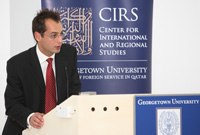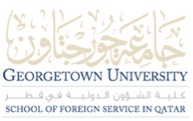Work in Progress:
Retailer Pass-Through and its Determinants Using Scanner Data (pdf), with Nicola Zaniboni - Revised and resubmitted, JIE. This version: July, 2013
Abstract: We study exchange rate pass-through and its determinants using scanner data on about 85% of the fast moving consumer goods (FMCGs) sold by 1,041 outlets in the United Arab Emirates between January of 2005 and December of 2010. The data, re-ported at the barcode level at each outlet, are augmented with Country-of-Origin (COO) information collected from the product labels.
Our main finding is that exchange rate pass-through varies more across retailers within regions than across regions, and in particular that pass-through increases with retailer market share. We also show that exchange rate pass-through is negatively correlated with product quality and with the elasticity of substitution of the product category. We interpret our main finding that pass-through increases with retailer size to strongly suggest that retailers exhibit heterogeneity in price-setting behavior.
Heterogeneous Firms, Quality, and Trade (pdf), submitted - New version, May 2013
Abstract: We present a simple and tractable trade model of heterogeneous firms, endogenous quality choice, and endogenous markups. A key feature of the model is that competition not only lowers the cost threshold between the firms that produce and those that exit, but it also raises the scope for quality differentiation. With both these channels present, the most productive firms respond to competition by raising quality, prices, and markups, while the least productive either exit or respond in the exact opposite manner.
The model generates a unified theory and a supply-side explanation for an extremely rich set of stylized facts related to (i) firm heterogeneity, (ii) product quality heterogeneity, (iii) markups heterogeneity, (iv) heterogeneity in the response of firms to competition, and (v) heterogeneity in the sign and magnitude of the correlations between output prices, firm productivity, size, and product quality. In addition, the model predicts that average price and markups exhibit a U-shape response to competition, that imports from developed countries are of higher quality and cost more than imports from developing countries, and that welfare gains are substantially understated when trade-induced competition is accounted for, but not trade-induced innovation.
On Altruism and Remittances (pdf), submitted - This version, September 2013
Abstract: We present a simple and tractable trade model of heterogeneous firms, endogenous quality choice, and endogenous markups. A key feature of the model is that competition not only lowers the cost threshold between the firms that produce and those that exit, but it also raises the scope for quality differentiation. With both these channels present, the most productive firms respond to competition by raising quality, prices, and markups, while the least productive either exit or respond in the exact opposite manner.
The model generates a unified theory and a supply-side explanation for an extremely rich set of stylized facts related to (i) firm heterogeneity, (ii) product quality heterogeneity, (iii) markups heterogeneity, (iv) heterogeneity in the response of firms to competition, and (v) heterogeneity in the sign and magnitude of the correlations between output prices, firm productivity, size, and product quality. In addition, the model predicts that average price and markups exhibit a U-shape response to competition, that imports from developed countries are of higher quality and cost more than imports from developing countries, and that welfare gains are substantially understated when trade-induced competition is accounted for, but not trade-induced innovation.
Ideologies, Media Branding, and the Hostile Media Effect: Perceptions of Al Jazeera and CNN (pdf), - This version, April 2013
Abstract: Understanding how media affects the formation of perceptions is key, especially on issues such as the rising Anti-Americanism and skepticism toward US foreign policy in the Middle East. In this article we examine and reject the notion that Muslims may perceive balanced media coverage on sensitive or controversial issues to be biased against them, a phenomenon known as the “hostile media effect.” To establish this, we conducted an experiment in Qatar where we asked 581 participants, both Muslims and non-Muslims, to evaluate a 2006 Al Jazeera news clip on the controversy generated from the publication of twelve cartoons depicting the prophet Mohammad by Denmark’s largest newspaper. In order to check how media branding affected perception, the Al Jazeera logo was replaced with that of CNN for half of the participants.
Our results show no difference in the assessment of coverage slant between Muslims and non-Muslims and no evidence of a less favorable assessment of the CNN clip by Muslims. In contrast, we find that participants who ex-ante considered CNN to be biased were more likely to assess coverage to be biased, and this effect was stronger for non-Muslims. Our findings suggest that it is largely the policies themselves, combined with biased media, and not audience ideologies that drive perceptions.
Danish Cartoons, Muslim Outcry, and the Response of Multi-product brands (pdf), - This version, September 2013
Abstract: On January 26th 2006, in response to the publication of 12 cartoons depicting the prophet Mohammad by Jyllands-Posten, Denmark’s largest newspaper, the imams in Saudi Arabia called for a boycott on Danish products during the Friday prayers. Using scanner data on sales of cheese products in Saudi Arabia between 2005 and 2009 across hundreds of outlets I document that the boycott was devastating for Danish firms: their market share collapsed from 17% in January to below 1% in February. Even four years after the boycott ended, their market share never recovered. In December 2009 it was at just 5%.
The boycott provides a natural experiment to study how multi-product brands respond to economic shocks. I find that the drop in Danish sales came from the intensive margin, whereas the gains of non-Danish came from the extensive. Interestingly, half of the non-Danish brands benefited but the other half did not, which I attribute to different strategies they undertook in response to the boycott. Specifically, the well-known brands benefited from raising their prices but also from the increased competition that resulted from the introduction of new products in response to the boycott. In contrast, the increased competition hurt sales of fringe brands, especially those that raised prices in response to the boycott
Six Facts About Retailers*
Macroeconomic Implications of Retailer Behavior**
Prices, Promotions, and Macroeconomics**
* Preliminary draft will be available in October. ** Preliminary drafts available soon.
Publications:
Local versus Producer Currency Pricing: Evidence from Disaggregated Data, International Economic Review, Vol 53(4), November 2012 (pdf)
Abstract: The pricing behavior of firms is a central issue in international macroeconomics. Whether firms set prices in the currency of the producer or the consumer is critical for policy because a devaluation succeeds in increasing demand for a country’s goods when the prices are rigid in the currency of the producer, but not if the prices are rigid in the currency of the consumer. Using the introduction of the euro as a natural experiment, I find that import price volatility among Eurozone members dropped dramatically after the introduction of the euro. Additionally, I show that the magnitude of the drop commensurate with the drop in exchange rate volatility. On the other hand, when looking at exports, I find that the introduction of the euro had no impact on export price volatility. The results support the presence of pricing in the currency of the producer.
The Gulf Monetary Union, forthcoming in The Political Economy of the Persian Gulf, edited by M. Kamrava, Columbia University/Herst 2012 (pdf)
Abstract: I evaluate the political economy of the Gulf Monetary Union (GMU). From a political perspective, I argue that the GMU will increase bargaining power at the supranational level, but it will also raise tensions across members and within. From an economics perspective, the Union will have a positive, yet limited, impact through an increase in intra-industry trade among members. Where the GMU process can have the biggest impact is in improving economic efficiency and enhancing the quality of institutions. A successful monetary union requires discipline, transparency, accountability, institutional independence, coordination, communication, sharing, expanded research capacities and improved statistical frameworks. If the process towards establishing the GMU encourages the candidates to expedite their work towards meeting these requirements, then the countries, through a strengthening in the quality of their institutions, will achieve long-term growth, low inflation, and macroeconomic stability. Most importantly, these benefits will come with or without the GMU being established at the end.
"Taking the Pulse of the Tech Sector: A Coincident Index of High-Tech Activity” (with Bart Hobijn, and Kevin Stiroh), Federal Reserve Bank of New York’s Current Issue in Economics and Finance, Vol 9(10), Oct 2003 (pdf)
Abstract: A new index of the U.S. high-tech sector - drawing upon a range of technology-specific data - has the potential to offer a more timely assessment of economic activity than has been possible to date. The index suggests that while the tech sector has rebounded from its poor performance in the 2000-01 "tech bust," it has not resumed its rapid expansion of the late 1990s.
- In the News: Forbes 2003
“Goods and Services Price Inflation: Recent Behavior and Historical Relationship” (with Richard Peach, and Robert Rich), Federal Reserve Bank of New York’s Economic Policy Review, Vol 10(3), December 2004 (pdf)
Abstract: Since the late 1990s, the combination of relatively high services inflation and declining goods prices has produced a record-level gap in these inflation rates. Some commentators argue that if the gap between services and goods inflation continues to expand in this manner, the outcome will be either faster overall inflation or deflation. This article examines the relationship between these divergent inflation rates from 1967 to 2002. The authors find that while the level of each inflation rate is subject to permanent shifts, the gap between services inflation and goods inflation over time remains stable. Moreover, when the gap is above its long-run value, as it currently is, equilibrium is restored through a rise in goods inflation and a slowing of services inflation. Their results suggest that concerns over an imminent marked acceleration or dramatic slowing in inflation may be unwarranted.



